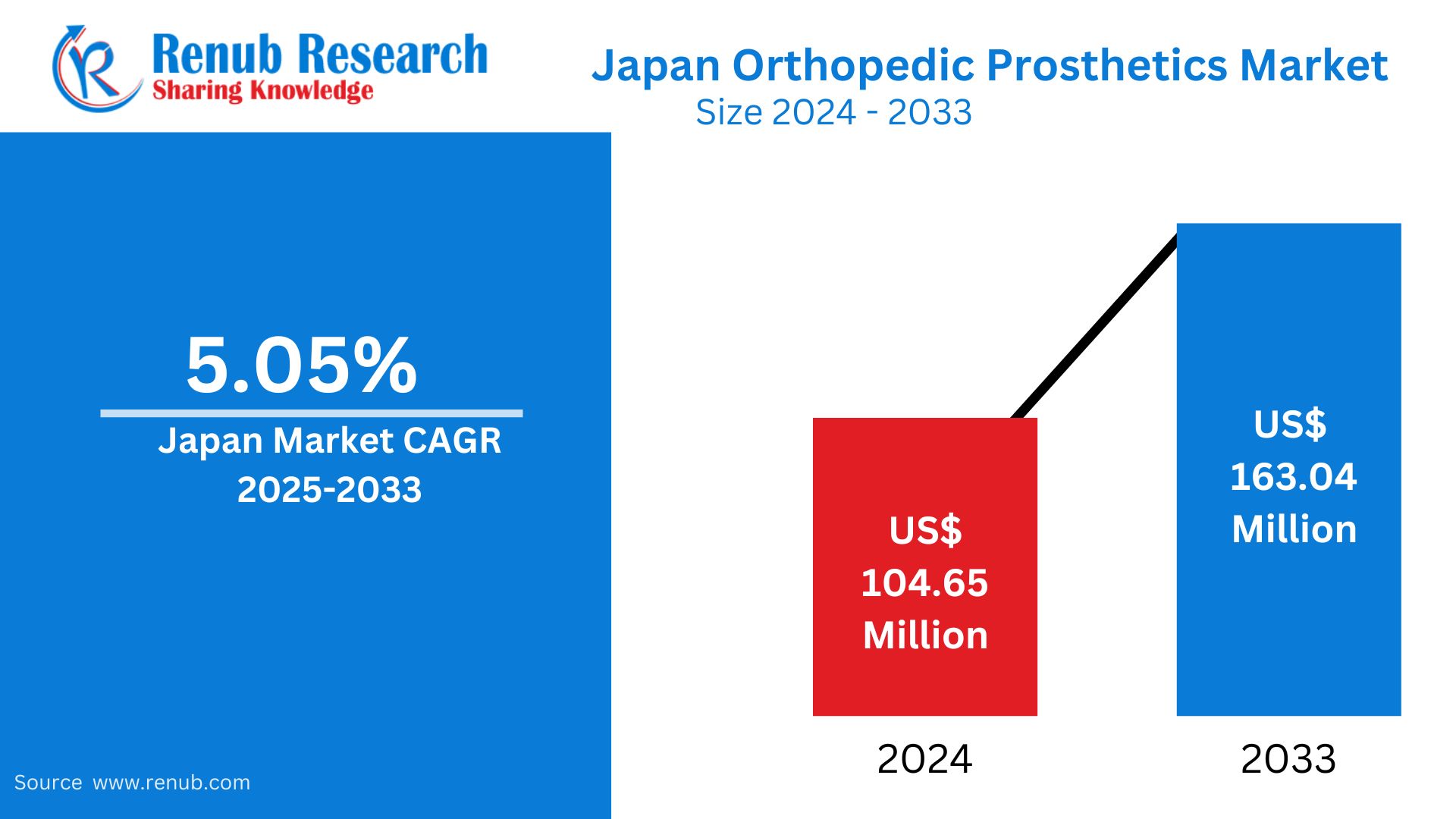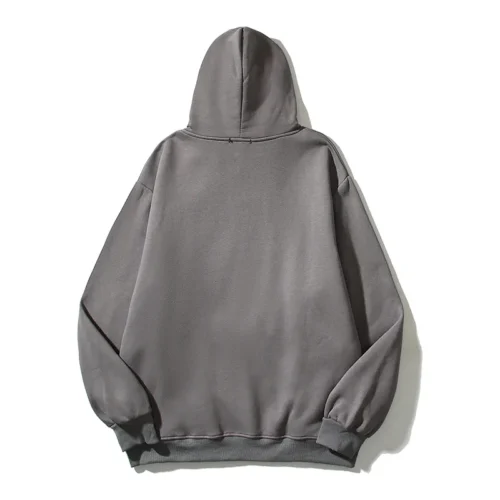Japan Orthopedic Prosthetics Market Witnessing Steady Growth Amid Rising Demand for Mobility Solutions
According to the latest report by Renub Research, the Japan Orthopedic Prosthetics Market is projected to grow from US$ 104.65 million in 2024 to US$ 163.04 million by 2033, expanding at a CAGR of 5.05% between 2025 and 2033. The increasing elderly population, growing prevalence of orthopedic conditions, improved healthcare infrastructure, and acceptance of technologically advanced prosthetics are key market drivers.
Japan’s Aging Population and Rising Orthopedic Conditions Fuel Market Demand
Japan is home to one of the world’s oldest populations, with over 29% of its citizens aged 65 and above. This demographic shift is significantly impacting the demand for orthopedic prosthetics as age-related degenerative diseases such as osteoarthritis and osteoporosis become more prevalent. Moreover, a rise in accidents, diabetes-related amputations, and sports injuries is further driving the need for effective prosthetic solutions in the country.
Government Support and Healthcare Infrastructure Strengthen Market Prospects
Japan’s universal healthcare system provides comprehensive coverage for prosthetic devices, making them more accessible. Additionally, government initiatives supporting assistive technologies and rehabilitation programs are enhancing adoption rates. Public-private partnerships and subsidies are also facilitating better access to innovative prosthetic solutions, especially for the elderly and disabled population.
Technological Innovations Transforming the Orthopedic Prosthetics Market in Japan
With rapid advancements in materials science and biomechanics, modern prosthetic devices are now more durable, lightweight, and user-friendly. Developments such as:
- Myoelectric prosthetics for limb replacements
- Microprocessor-controlled knees (MPKs)
- 3D-printed customized prosthetics
- Smart sensors and AI-assisted gait analysis
are revolutionizing patient experience, allowing for more natural movement and greater autonomy. Japan’s focus on robotics and AI, particularly in healthcare, further strengthens the country’s position in embracing cutting-edge prosthetic technologies.
Segmentation Analysis: By Type, Application, End-User, and Region
By Type:
- Lower Limb Prosthetics
- Upper Limb Prosthetics
- Liners
- Sockets
- Others
Lower limb prosthetics dominate the market due to a higher incidence of amputations caused by diabetes and age-related vascular diseases.
By Application:
- Trauma-related injuries
- Diabetes-related amputations
- Congenital disorders
- Arthritis and degenerative joint diseases
Among these, trauma and diabetic-related amputations hold significant market share due to lifestyle factors and aging.
By End-User:
- Hospitals
- Prosthetic Clinics
- Rehabilitation Centers
- Home Care Settings
Hospitals and prosthetic clinics collectively account for the largest share due to their access to skilled professionals and integrated post-surgical rehabilitation support.
By Region (Cities Covered):
- Tokyo
- Kansai (Osaka, Kyoto, Kobe)
- Aichi (Nagoya)
- Kanagawa (Yokohama)
- Saitama
- Hyogo
- Chiba
- Hokkaido
- Fukuoka
- Shizuoka
Tokyo and Kansai regions are the leading markets due to their concentration of healthcare institutions, high population density, and advanced infrastructure.
Competitive Landscape: Japan’s Market Attracts Global and Domestic Players
The Japanese orthopedic prosthetics market is moderately consolidated, with both domestic and international players competing for market share. Key companies operating in the space include:
- Össur
- Ottobock
- Blatchford
- WillowWood Global
- Touch Bionics Inc.
- Nabtesco Corporation
- Teijin Nakashima Medical Co., Ltd.
These companies are investing heavily in research and development to introduce high-performance prosthetics, enhance patient comfort, and integrate IoT and AI capabilities for smarter prosthetics.
Market Trends Shaping the Future of Prosthetics in Japan
- 3D Printing of Prosthetic Components: Custom-fit sockets and limbs through 3D printing are becoming popular for cost-effectiveness and patient comfort.
- Myoelectric Technology: Devices that respond to muscle movements provide greater control and functionality.
- Integration of Wearable Sensors: Real-time data monitoring of patient movement and prosthetic performance.
- Focus on Aesthetic and Functional Designs: Catering to both the emotional and practical needs of users.
- Collaborations with Robotics Industry: Tapping into Japan’s expertise in robotics to build smarter and more intuitive prosthetic limbs.
Challenges in the Market
Despite promising growth, the market still faces several challenges:
- High Cost of Advanced Prosthetics: Limits accessibility, especially for low-income patients.
- Shortage of Skilled Prosthetists and Orthotists: Slows down adoption in rural regions.
- Social Stigma and Psychological Barriers: Affect prosthetic adoption in some sections of society.
- Regulatory Hurdles: Lengthy product approval cycles could delay the launch of innovative solutions.
Future Outlook: Focus on Innovation, Customization, and Accessibility
The orthopedic prosthetics market in Japan is poised for sustained growth through 2033. Strategic collaborations between medical institutions, prosthetic manufacturers, and tech firms will accelerate the development of personalized, AI-integrated, and eco-friendly prosthetic devices. Government support, aging demographics, and patient awareness are expected to further boost demand.
For in-depth insights, market forecasts, and strategic recommendations, access the full report:
👉 Japan Orthopedic Prosthetics Market Report (2025-2033)
🧠 FAQs: Japan Orthopedic Prosthetics Market
1. What is the projected market size for orthopedic prosthetics in Japan by 2033?
The market is expected to reach US$ 163.04 million by 2033.
2. What is the growth rate of the market during the forecast period?
It is projected to grow at a CAGR of 5.05% from 2025 to 2033.
3. What factors are driving market growth?
Key drivers include Japan’s aging population, technological advancements in prosthetics, and increased healthcare accessibility.
4. Which segment holds the largest share of the market?
Lower limb prosthetics hold the dominant share due to the high incidence of lower limb amputations.
5. Which end-user segment is leading in terms of adoption?
Hospitals and prosthetic clinics lead the end-user segment due to their integrated services and infrastructure.
6. What role does 3D printing play in this market?
3D printing enables cost-effective, customized prosthetics that improve user comfort and mobility.
7. Who are the key players in Japan’s orthopedic prosthetics market?
Companies such as Össur, Ottobock, Nabtesco, and Teijin Nakashima Medical are prominent players.
8. What are the main challenges facing the market?
Challenges include the high cost of advanced devices, limited availability of specialists, and social stigma.
9. How does Japan’s healthcare system support this market?
Universal health insurance and government subsidies make prosthetics more accessible and affordable.
10. What future trends can we expect?
Trends include AI-assisted prosthetics, smart sensors, and robotics-integrated limb replacements.
New Publish Report:
- North America Surge Arresters Market Size and Growth Trends and Forecast Report 2025-2033
- North America Halal Food Market Size and Share Analysis – Growth Trends and Forecast Report 2025-2033
- North America Non-Lethal Weapons Market Size and Growth Trends and Companies 2025-2033
🏢 About the Company – Renub Research
Renub Research is a Market Research and Consulting Company with more than 15 years of experience, especially in international Business-to-Business Research, Surveys, and Consulting. We provide a wide range of business research solutions that help companies make better business decisions. We partner with clients across all sectors and regions to identify their highest-value opportunities, address their most critical challenges, and transform their businesses.
Our wide clientele includes key players in Healthcare, Travel & Tourism, Food & Beverages, Power & Energy, Information Technology, Telecom & Internet, Chemicals, Logistics & Automotive, Consumer Goods & Retail, Building & Construction, and Agriculture.
Our core team comprises experienced professionals with graduate, postgraduate, and Ph.D. qualifications in Finance, Marketing, Human Resources, Bio-Technology, Medicine, Information Technology, Environmental Science, and more.
📞 Media Contact
Company Name: Renub Research
Contact Person: Rajat Gupta, Marketing Manager
Phone No: +91-120-421-9822 (IND) | +1-478-202-3244 (USA)
Email: rajat@renub.com



